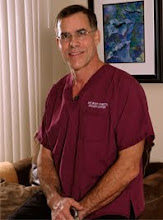 |
| Big Sur redwoods 2 |
The new sunscreens are fantastic compared to what existed in the past. There are two spectra of damaging light that sunscreens need to block: ultraviolet A (UVA) and ultraviolet B (UVB). The UVB are the burning rays, and the chemicals that are typically used in sunscreens do a pretty effective job of blocking these rays. The new chemicals don’t usually cause sensitivity or allergic reactions, either.
The big problem is UVA. These rays penetrate deeply into the skin, destroy facial fat deposits, and cause long-term damage that isn’t marked by immediate sunburn. There had been no chemical way to block these, so the clever scientists were able to make physical particles smaller and smaller until they could be rubbed into the skin and actually block out a great deal of the radiation. Formerly, zinc oxide (or Desinex) cream was used by skiers, lifeguards and other people who needed heavy-duty ultraviolet protection. Zinc oxide preparations were available in colors, so you may remember skiers putting colored cream on their noses and cheeks like war paint. However, the new preparations contain micronized (very, very small) particles that can be rubbed in, and are virtually colorless on the skin. These also generally don’t cause any allergies, but they might be a little bit less elegant than the more creamy chemicals that are used to block UVB.
Our particular proprietary sunscreen contains the particulate zinc and iron that can be rubbed into the skin and is a good alternative, particularly for those with dark skin. For those needing the total block, such as those being treated for dark spots on their skin, or people who’ve had cancers or who really understand how important it is to keep the sun off of their skin, we recommend Fallene Coat Total Block. This contains both the particulate block for the UVA and the chemical block for UVB. You can buy this online or in many pharmacies.
One last consideration is vitamin D deficiency, which is somewhat controversial but thought to be a relatively common thing due to the sunscreens. It doesn’t do any harm to take a vitamin D supplement, 5000 IU per day, which is more than is generally recommended by the FDA.




